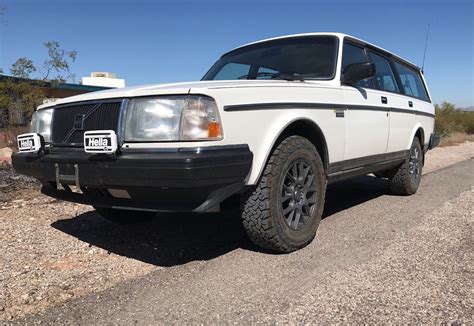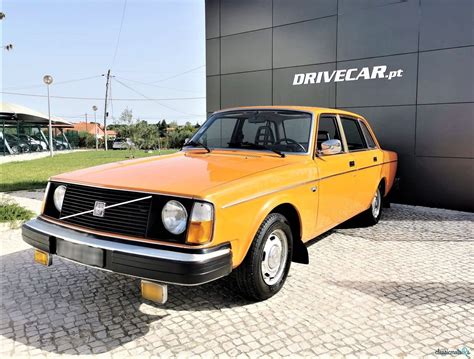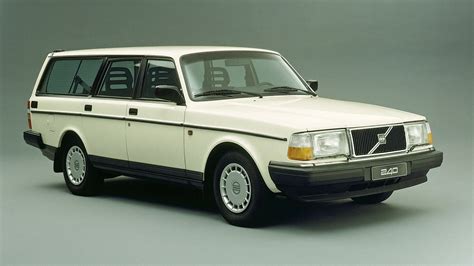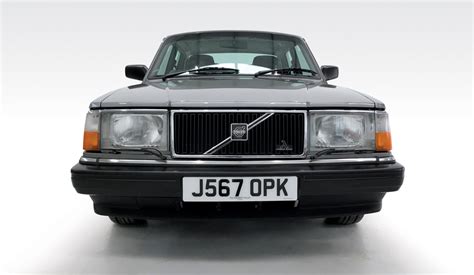Volvo 240 problems

The Volvo 200 Series (or 240 and 260 Series) is a range of mid-size cars produced by Swedish company Volvo Cars from 1974 until 1993, with more than 2.8 million total units sold worldwide. Like the Volvo 140 Series (1966 to 1974), from which it was developed, it was designed by Jan Wilsgaard.
The series overlapped production of the Volvo 700 Series (1982 to 1992). As the 240 Series remained popular, only the 260 Series was displaced by the 700 Series, which Volvo marketed alongside the 240 for another decade. The 700 was replaced by the 900 Series in 1992, a year before the 240 was discontinued. Production of the 240 ended on 14 May 1993, after nearly 20 years, with the basic platform and architecture lasting 27 years, if the production run of the original 140 Series is aggregated.
History
The Volvo 240 and 260 series were introduced in the autumn of 1974, and was initially available as six variations of the 240 Series (242L, 242DL, 244DL, 244GL, 245L and 245DL) and two variations of the 260 Series (264DL and 264GL). The 240 Series was available as a sedan (with two or four doors) or a station wagon, however, the 260 Series was available as a coupé (262C Bertone), two-door sedan, four-door sedan, or station wagon. The 200 looked much like the earlier 140 and 164, they shared the same basic body shell and were largely identical from the cowl rearward. However, the 200 incorporated many of the features and design elements tried in the Volvo VESC ESV in 1972, which was a prototype experiment in car safety. The overall safety of the driver and passengers in the event of a crash was greatly improved with very large front and rear end crumple zones. Another main change was the new engines offered, which were of an overhead cam design based on the earlier B20. The 260 series also received a V6 engine in lieu of the 164's inline-six.
The 200 Series had MacPherson strut-type front suspension, which increased room around the engine bay, while the rear suspension was a modified version of that fitted to the 140 Series. The steering was greatly improved with the introduction of rack-and-pinion steering, with power steering fitted as standard to the 244GL, 264DL and 264GL, and there were some modifications made to the braking system (in particular the master cylinder).
The front end of the car was also completely restyled with a "shovel nose" which closely resembled that of the VESC prototype vehicle – that being the most obvious change which made the 200 Series distinguishable from the earlier 140 and 160 Series. Other than all the changes mentioned above, the 200 Series was almost identical to the 140 and 160 Series from the bulkhead to the very rear end. In 1978, a facelift meant a redesigned rear end for sedans, with wraparound taillights and a trunk opening with a lower lip. The dashboard was derived from the safety fascia introduced for the 1973 model year 100 Series - the main change for the 200 Series was the adoption of slatted "egg crate" style air vents in place of the eyeball style vents used in the 140/160 and the square clock. All models were available with a choice of four-speed manual or a three-speed automatic transmission. Overdrive was also optional on the manual 244GL, while a five-speed manual gearbox was optional on the 264GL and 265GL.
In the autumn of 1975 (for the 1976 model year in America), the 265 DL estate became available alongside the existing range, and this was the first production Volvo estate to be powered by a six-cylinder engine. The choice of gearboxes was also improved, with overdrive now available as an option in all manual models except the base-model 242L and 245L. As before, a three-speed automatic was optional in every model. The B21A engine gained three horsepower; a new steering wheel and gearknob were also introduced.
At the 1976 Paris Motor Show Bertone first showed the stretched 264 TE, a seven-seat limousine on a 3,430 mm (135.0 in) wheelbase, although it had entered production earlier. The raw bodies were sent from Sweden to Grugliasco for lengthening, reinforcing, and finishing. Carl XVI Gustav of Sweden used one, as did much of East Germany's political leadership.
For 1977 the B19A engine with 90 PS (66 kW) replaced the B20A in most markets, although the old pushrod type soldiered on for another two years in some places. This is also the year that the sportier 242 GT arrived.
In 1978 the grille was altered, now with a chrome surround. Rear view mirrors were now black, while the front seats were changed as were the emblems, while interval wipers were introduced. 1978 models were also the first 240s to receive a new paint formula, to help solve the severe rust problems in previous model years.
The 1979 model year brought a full facelift front and rear, the most obvious change being the adoption of flush fitting square headlamps on the DL or rectangular headlamps on the GL, GLE in place of the recessed circular units. The sedans received new wraparound rear lamp clusters and a restyled leading edge to the trunk lid, while the rear of the wagons remained unchanged. The GLE was added while the L was cancelled, and the six-cylinder diesel arrived late in the year. For 1980, the sporty GLT arrived, replacing the GT. For 1981 there was yet another new grille, while the station wagons received new, wraparound taillights. The B21A gained some four horsepower, now 106 PS (78 kW), while the carburetted B23A with 112 PS (82 kW) was introduced in some markets. The Turbo arrived, while six-cylinder models now had a more powerful 2.8-liter engine. 1981 also saw the dashboard altered significantly, which a much larger binnacle in order to bring the radio and clock within the driver's line of sight. The instrument pod itself, which had been unaltered since the 1973 model year 100 Series, was also redesigned.
Incremental improvements were made almost every year of the production run. One of the major improvements was the introduction of the oxygen sensor in North America in late 1976 (1977 models), which Volvo called Lambda Sond and developed in conjunction with Bosch. It added a feedback loop to the Jetronic fuel injection system already in use, which allowed fine-tuning of the air and fuel mixture and therefore produced superior emissions, drivability and fuel economy.
For the 1983 model year, Volvo dropped the DL and GLE labels, selling the cars simply as 240s. In the domestic Swedish market, the 240 could be had with a 2.1 or 2.3-liter engine (more options were available in export), but the bigger engine always came coupled with a five-speed transmission and tinted windows. The 1983s also received wider side trim and all models had the larger taillights introduced on the previous year's GLT model. A B23E-engined GLE variant was also added (not available with two doors). Buyers protested against the lack of grades and they returned for 1984. A new manual gearbox also arrived for 1984, while a four-speed automatic option was available in the GL. The GLT and Turbo versions received a taller grille.
While Volvo had been planning to discontinue the 200-series since the early 1980s, the design kept selling well and Volvo provided steady updates. In late 1991, for the 1992 model year, it received 160 detail improvements including changes to the heater controls, heated rear view mirrors, and revised front seats. For the final, 1993 model year, air conditioning units were upgraded to use R-134a rather than the ozone-depleting R-12 (Freon).
About one-third of all 240s sold were station wagons, which featured very large cargo space of 41 cubic feet (1.2 m3). They could be outfitted with a rear-facing foldable jumpseat in the passenger area, making the wagon a seven-passenger vehicle. The jumpseat came with three-point seat belts, and wagons were designed to have a reinforced floor section, protecting the occupants of the jumpseat in the event of a rear-end collision.
A 1993 Volvo 240DL was driven by IKEA founder Ingvar Kamprad, who stopped driving it when he was told the car was too dangerous due to outdated safety design two decades later.
The last 200 produced was a blue station wagon built to the Italian specification and named the "Polar Italia", currently displayed at the Volvo World Museum. It was manufactured the 14th May 1993.

Social links
Volvo 240 model years















Common Volvo 240 problems
The Volvo 240 is known for its robust build and durability, but like any other vehicle, it has its common problems. Here are some of the most frequently reported issues with the Volvo 240, based on complaints from owners:
- Worn Air Intake Hose & Air Box Thermostats: The air intake hose and air box thermostats can wear out or fail, causing unfiltered air to enter the engine and affecting cold start performance.
- Fuel Injection Relay: The main fuel pump relay can fail, causing intermittent or no start issues.
- Main Fuses: The main fuse box is prone to corrosion and can cause numerous problems, including intermittent or no start issues.
- Heater Blower Motor: The heater blower motor can fail, requiring replacement, which can take 3-4 hours for an experienced mechanic.
- Lumbar Support Systems: The lumbar support systems in the seats can fail between 50-100,000 miles, causing discomfort for drivers.
- Motor & Transmission Mounts: The engine and transmission mounts can wear out quickly, requiring regular replacement.
- Odometer Gear: The plastic gear that drives the odometer can split, causing erratic or complete loss of odometer & trip meter function.
- Transmission Overdrive Inoperative: The transmission overdrive can become inoperative, causing upshift arrow to stay on all the time.
- Blown Fuses: The Volvo 240 is known for its tendency to blow fuses due to the fuse box's location under the dashboard, making it easier for exterior water to make its way in and cause corrosion.
It's important to note that these issues are not necessarily indicative of poor design or defects, but rather common problems that can arise in any vehicle, especially those that have been on the road for a long time. Regular maintenance and inspections can help prevent or address these issues before they become major problems.

Is the Volvo 240 a reliable car?
The 240 is 100% reliable and is built VERY strong. It was designed for safety, and it was designed for reliability.
Was there any known issues with the Volvo 240?
The 240 is notorious for having an awesome heater, however, the heater blower motor is buried in the deepest confines of the dash, almost like Volvo built the car around the heater motor, and over time can experience bearing failure, leading to an ear-piercing squeal, or all-out failure.
What is the life expectancy of a Volvo 240?
What is Volvo 240 lifespan? The estimated lifespan of a Volvo 240 is 380,000mi, before reaching the life expectancy upper limit. Fuel type is a major factor when looking into a vehicles lifespan/life expectancy.
Why is the Volvo 240 so popular?
More than anything else, it was the car's crash safety properties combined with the fine driving characteristics which attracted attention when the car appeared on the market the world over. for Highway Safety, IIHS, cited the Volvo 240 Estate as the safest car on the American market.
Percentage distribution of complaints by Volvo 240 years
We have researched Volvo problems and analysed all the complaints filed against Volvo 240 cars and compiled the top 5 most problematic Volvo 240 model years:
Below you can see the percentage distribution of known problems by Volvo 240 model years.
Distribution of the number of complaints by Volvo 240 years
We've also compiled a chart for you with the number of complaints about Volkswagen Jetta cars of certain model years:
Volvo 240 car problems categorized by type of issue
After analysing all complaints related to Volvo 240 , it was concluded that the most common issues with these cars are:
- Electrical system problems
- Vehicle speed control problems
- Power train problems
- Service brakes problems
- Hydraulic problems
The graph below shows statistics for all Volvo 240 vehicle components and the number of complaints received.
Distribution of the number of complaints where the accident occurred by 240 model years
A total of 18 complaints were registered in which the accident occurred. In the graph you can see the distribution of the number of complaints by model year.
Distribution of the number of complaints with fire by 240 model years
There were a total of 7 complaints that resulted in a fire. In the graph you can see the distribution of the number of complaints by model year.
Distribution of the number of complaints with injuries by 240 model years
There were a total of 10 complaints that resulted in a injuries. In the graph you can see the distribution of the number of complaints by model year.
The NHTSA has received 117 complaints about various vehicle components related to the Volvo 240 . Below are the 25 most recent complaints reported for Volvo 240 vehicles.
Latest 25 complaints
Volvo 240 1991
- Date Of Incident: 2017-11-24
- Date Complaint: 2018-03-22
- Crash: 1
- VIN: YV1AA8843M1
- Components: EXTERIOR LIGHTING,AIR BAGS,FUEL/PROPULSION SYSTEM
- Summary: "TAKATA RECALL" UNKNOWN
Volvo 240 1986
- Date Of Incident: 2017-03-22
- Date Complaint: 2017-06-02
- Fire: 1
- VIN: YV1AX8840G1
- Components: EXTERIOR LIGHTING
- Summary: I OWNED A 1986 240 GL VOLVO 4 DOOR SEDAN. ONE NIGHT LAST MONTH MY WIFE WAS DRIVING HOME AND WITHIN A BLOCK OF OUR HOUSE SHE NOTICED A FIRE ON THE BACK OF THE CAR. THE DRIVER'S SIDE TAIL LIGHT WAS ON FIRE. I CONTACTED VOLVO USA AND ABOUT A MONTH LATER THEY HAD AN "EXPERT" INSPECT OUR CAR. THEY WILL NOT GIVE ME A WRITTEN REPORT. THE EXECUTIVE, JOSEPH ([email protected]) CALLED ME AND LEFT A MESSAGE SAYING THAT WE HAD TOO LARGE OF A FUSE IN THE FUSE BLOCK AND THIS IS WHAT CAUSED THE FIRE. I'VE TRIED REPEATEDLY TO TELL THEM THAT TOO LARGE OF A FUSE DIDN'T CAUSE THE DEAD SHORT FIRE ON OUR TAIL LIGHT. I GOOGLED TAIL LIGHT FIRES ON VOLVO'S AND FOUND SEVERAL PAGES. I'VE HAD TO SCRAP THE CAR. THE TOW TRUCK DRIVER WASN'T SHOCKED TO SEE THE MELTED TAIL LIGHT ON MY VOLVO. HE TOLD ME HE HAD A 1984 VOLVO JUST LIKE MINE AS HIS FIRST CAR. HE SAID HIS TOO HAD THE SAME MELTED TAIL LIGHT FIRE AS MINE.
Volvo 240 1991
- Date Of Incident: 2001-10-03
- Date Complaint: 2015-10-28
- Number Of Injuries: 1
- Crash: 1
- Components: SEATS
- Summary: I JUST SAW ON THE NEWS ABOUT SEATS FALLING BACK DURING ACCIDENT WHEN I WAS HIT BY A TRACTOR-TRAILER IN 2002 TWO VOLVO 240 MY SEAT WENT ALL THE WAY BACK LIKE THE NEWS SHOWED LUCKILY NO ONE WAS IN THE REAR SEAT
Volvo 240 1990
- Date Of Incident: 2014-10-06
- Date Complaint: 2014-11-04
- Number Of Injuries: 1
- Crash: 1
- Fire: 1
- VIN: YV1AA8855L1
- Components: ELECTRICAL SYSTEM,VEHICLE SPEED CONTROL
- Summary: TL* THE CONTACT OWNED A 1990 VOLVO 240 WAGON. THE CONTACT STATED THAT THE BATTERY WAS CONTINUOUSLY FAILING. THE VEHICLE WAS TAKEN TO A SERVICE STATION FOR INSPECTION. THE MECHANIC ADVISED THE CONTACT TO DRIVE THE VEHICLE INTO THE SERVICE BAY AREA. AS SOON AS SHE SHIFTED FROM PARK, THE VEHICLE SUDDENLY ACCELERATED. THE CONTACT APPLIED THE BRAKES BUT THE VEHICLE DID NOT RESPOND. THE CONTACT MADE A HARD LEFT TURN TO AVOID CRASHING INTO THE FRONT ENTRANCE OF THE SHOP AND CRASHED INTO A WALL INSTEAD. THE BUILDING IMMEDIATELY BECAME FILLED WITH WHITE SMOKE AND A STRONG ODOR OF BURNING RUBBER. THE VEHICLE ONLY CAME TO A STOP DUE TO THE OBSTRUCTIONS BUT WAS STILL ATTEMPTING TO ACCELERATE. THE CONTACT HAD TO BE EXTRACTED FROM THE VEHICLE BY EMERGENCY RESPONDERS WITH A SLEDGE HAMMER, AND THE WALL HAD TO BE OPENED IN ORDER TO REMOVE THE CONTACT FROM THE VEHICLE. THE VEHICLE WAS STILL ATTEMPTING TO ACCELERATE WHEN THE CONTACT WAS REMOVED. HOWEVER, THE VEHICLE WAS UNABLE TO MOVE ANY FURTHER DUE TO THE OBSTRUCTION OF THE WALL. THE AMBULANCE ARRIVED TO THE SCENE BUT BECAUSE THE CONTACT WAS IN A STATE OF SHOCK, REFUSED MEDICAL TRANSPORT. THE MANUFACTURER WAS MADE AWARE OF THE FAILURE AND A POLICE REPORT WAS FILED OF THE INCIDENT. THE FAILURE WAS NEITHER DIAGNOSED NOR DUPLICATED. THE FAILURE MILEAGE WAS 129,000.
Volvo 240 1990
- Date Of Incident: 2014-10-06
- Date Complaint: 2014-10-27
- Crash: 1
- VIN: YV1AA8855L1
- Components: ELECTRICAL SYSTEM,VEHICLE SPEED CONTROL,SERVICE BRAKES
- Summary: TL* THE CONTACT OWNS A 1990 VOLVO 240. THE CONTACT STATED THAT WHEN SHIFTING FROM PARK, THE VEHICLE BEGAN TO ACCELERATE AND THE BRAKES FAILED. AS A RESULT, THE VEHICLE CRASHED INTO THE GLASS DOORS OF THE AUTO DEPARTMENT AND THROUGH THE BUILDING. THE VEHICLE WAS TOWED TO THE DEALER FOR DIAGNOSIS. THE MECHANIC WAS UNABLE DIAGNOSE THE FAILURE AND THE VEHICLE WAS NOT REPAIRED. THE MANUFACTURER WAS NOTIFIED OF THE FAILURE. THE APPROXIMATE FAILURE MILEAGE WAS 129,000. UPDATED 01/05/14*LJ THE CONSUMER STATED THE VEHICLE WAS INITIALLY BROUGHT IN FOR REPAIRS DUE TO THE VEHICLE CONSTANTLY SHUTTING OFF.*JS
Volvo 240 1988
- Date Of Incident: 1992-04-07
- Date Complaint: 2014-10-22
- Number Of Injuries: 1
- Crash: 1
- Components: SEAT BELTS
- Summary: I WAS DRIVING TO WORK AND IT WAS DARK AND FOGGY. I WAS GOING SLOWLY AROUND A CURVE, AT THE SPEED LIMIT ABOUT 20MPH, AND A TEENAGE DRIVER, DRIVING ALONE WITHOUT A PERMIT DROVE THROUGH A YIELD SIGN FROM THE RIGHT DIRECTLY INTO MY PATH. I HAD ABOUT 8 FEET TO STOP AND COULD NOT, AND T-BONED INTO THE DRIVERS SIDE. I HAD MY SEAT BELT ON BUT I WAS THROWN FORWARD AND MY HEAD HIT THE WINDSHIELD AND MY HEAD LEFT A SWELL IN THE WINDSHIELD, LIKE A LUMP OR DENT, AND THE GLASS WAS SHATTERED SOMEWHAT BUT ALL STILL INTACT. NONE THE LESS I REMAINED CONSCIIOUS BUT STILL HAD A MINOR CONCUSSION WHICH GAVE ME HEADACHES FOR UP TO ABOUT 8 WEEKS AFTERWARDS. I SOUGHT MEDICAL ATTENTION BUT THEY FELT THERE WAS NOTHING THEY COULD DO BUT SAID TO COME BACK IF IT GOT WORSE. I REMEMBER THAT I OFTEN WONDERED IF THERE WAS A PROBLEM WITH THE SEATBELT. IT WOULD SOMETIMES LOCK WHEN I PUT IT ON, BUT SOMETIMES, AND FREQUENTLY IT DID NOT LOCK IN. THAT IS EVEN THOUGH IT LOCKED INTO THE CLAMP, IT WAS OFTEN STILL LOOSE. SO ANYWAY IT WAS LOOSE AND DIDN'T RESTRAIN ME THAT TIME WHEN I NEEDED IT. I DON'T KNOW AFTER ALL THESE YEARS IF THERE ARE TOO MANY OF THESE ON THE ROAD. *TR
Volvo 240 1989
- Date Of Incident: 2011-12-17
- Date Complaint: 2011-12-20
- VIN: YV1AX8843K1
- Components: POWER TRAIN
- Summary: TL* THE CONTACT OWNS A 1989 VOLVO 240 DL. THE CONTACT STATED THAT DIFFERENTIAL FLUID WAS LEAKING FROM THE VEHICLE. THE VEHICLE WAS TAKEN TO A PRIVATE MECHANIC WHO CONFIRMED THE FAILURE AND ALSO DISCOVERED THAT THERE WAS CORROSION NEAR THE REAR AXLE AND DIFFERENTIAL COVER. THE VEHICLE WAS NOT REPAIRED. THE MANUFACTURER WAS MADE AWARE OF THE FAILURE. THE FAILURE AND THE CURRENT MILEAGE WAS 140,000.
Volvo 240 1990
- Date Of Incident: 2011-10-24
- Date Complaint: 2011-10-30
- VIN: 1GCEV14H5HF
- Components: TIRES
- Summary: GOODYEAR VIVA 2 TIRES FROM WALMART HAVE GONE OUT-OF-ROUND REPEATEDLY. THE MECHANICS AT ANOTHER TIRE SHOP SAY THEY SEE THIS ALL THE TIME WITH WALMART GOODYEARS. I GAVE UP ON WARRANTY REPLACEMENTS, SINCE THEY ALSO FAIL, AND I HAVE TWO DAUGHTERS AND A WIFE DRIVING THESE CARS WITH FAILING TIRES. I SACRIFICED THE WARRANTIES AND PUT KUMHOS ON THE CARS. I HAVE 6 VOLVO 240S AND ALL OF THEM HAVE HAD FAILURES OF WALMART TIRES. GOODYEAR, DOUGLAS AND UNIROYAL. 185 -70 - 14. IN EVERY CASE THE TIRES GO OUT-OF-ROUND AND CANNOT BE BALANCED. THEY WOBBLE AND SHAKE, BECAUSE OF BUBBLES IN THE SIDEWALLS AND THE TREAD FACE, OR FLAT SPOTS IN THE TREAD FACE, WHERE THE BELTS OR BANDS INSIDE THE TIRE ARE SEPARATING AND THE TIRE STRUCTURE ITSELF IS FAILING. IN EVERY CASE THE TIRES ARE A FEW MONTHS OLD AND STILL HAVE THE BRAND NEW MOLD NIPPLES, AND THE TREAD DEPTH IS ALMOST BRAND NEW. I HAVE TAKEN THE CARS TO FRONT END ALIGNMENT SHOPS AND NONE OF THEM NEEDED SUSPENSION PARTS OR ALIGNMENT - IT HAS BEEN TIRE FAILURE SHAKING THE CARS. I HAVE HAD AT LEAST 8 OF THESE TIRES FAIL IN THIS MANNER. *TR
Volvo 240 1989
- Date Of Incident: 2010-12-17
- Date Complaint: 2010-12-20
- Components: EQUIPMENT
- Summary: TL*THE CONTACT OWNS 1989 VOLVO 240 DL. WHILE THE VEHICLE WAS PARKED THE CONTACT NOTICED THAT THE GASKETS OF THE WALKER PART NUMBER 35145 EXHAUST RUBBER INSULATOR HANGERS FOR THE REAR MUFFLER HAD CRACKED AND DISINTEGRATED. THE VEHICLE WAS NOT TAKEN TO THE DEALER FOR REPAIRS. THE VIN WAS NOT AVAILABLE. THE APPROXIMATE FAILURE MILEAGE WAS 200,000.
Volvo 240 1987
- Date Of Incident: 2009-10-22
- Date Complaint: 2010-04-13
- Components: EXTERIOR LIGHTING,EQUIPMENT
- Summary: DEFECTIVE REPLACEMENT HEADLAMP FIXTURE PARTS (NON-COMPLIANT WITH FEDERAL MOTOR VEHICLE SAFETY STANDARDS CRASH AVOIDANCE - STANDARD NO. 108 IN PART 571). THESE REPLACEMENT HEADLAMP FIXTURES (RIGHT AND LEFT) WERE PURCHASED FOR A 1987 VOLVO 240 WAGON. NOTE THESE SAME LAMP FIXTURES ARE USED IN VARIOUS TRUCKS AND RVS. BOTH THE LEFT AND RIGHT HAND VERSIONS OF THESE NEW PARTS LACKED MUCH OF THE SILVER REFLECTIVE COATING AROUND THE BULB AREA, SUGGESTING THIS IS RECURRING QUALITY CONTROL PROBLEM. JPEG PHOTOS ARE AVAILABLE ON REQUEST SHOWING HEADLAMP LIGHT ILLUMINATING THE ENGINE COMPARTMENT THROUGH THE UNSILVERED PARTS OF THE REFLECTORS. SO MUCH SILVER COATING IS MISSING FROM THE LEFT SIDE FIXTURE, THE UNLIT HEADLIGHT BULB CAN BE SEEN THROUGH THE REFLECTOR! THE PARTS ARE LABELED ACROSS THE BOTTOM OF THE LENS AS "DJAUTO MVV111-C1RO (FOR RIGHT SIDE OR C1LO FOR THE LEFT SIDE) 14V 7H DOT SAE HR00" WITH "HB1" IN THE UPPER OUTSIDE CORNERS. THESE PARTS WERE PURCHASED FROM LAMPSANDLENSES - MVP IMPORTS, LLC - FRANK'S FOREIGN AUTO, 595 VALLEY STREET, ORANGE, NJ 07050, TEL # 973-674-2254 ON 10/22/09. A COPY OF THE RECEIPT IS AVAILABLE. NOTE PARTS ARRIVED IN UNLABELED PLAIN BROWN BOXES AND COST $69.99 EACH OR $139.98 TOTAL. *TR
Volvo 240 1989
- Date Of Incident: 2009-06-23
- Date Complaint: 2009-06-24
- Components: TIRES
- Summary: TL*THE CONTACT OWNS A 1989 VOLVO 240. THE VEHICLE HAS GOODYEAR EAGLE GPH TIRES, SIZE P195/65/R15 (NA). WHILE DRIVING LESS THAN 60 MPH, THE CONTACT HEARD A LOUD NOISE COMING FROM THE REAR OF THE VEHICLE. THE SOUND WAS SIMILAR TO A FLAPPING NOISE AND THE VEHICLE BEGAN PERFORMING DIFFERENTLY. SHE PULLED THE VEHICLE OVER AND NOTICED THAT THE REAR DRIVER'S SIDE TIRE WAS SHREDDED AROUND THE ENTIRE CIRCUMFERENCE OF THE TIRE. THERE WERE NO RECALLS LISTED FOR HER PARTICULAR TIRE SIZE; HOWEVER, THERE WAS A RECALL FOR THE P195/60/R15 SIZE TIRE. THE VIN WAS UNKNOWN. THE FAILURE AND CURRENT MILEAGES WERE LESS THAN 16,000.
Volvo 240 1988
- Date Of Incident: 2007-08-24
- Date Complaint: 2008-01-14
- VIN: YV1BX4549B1
- Components: TIRES
- Summary: TL*THE CONTACT OWNS A 1988 VOLVO 240. THE VEHICLE HAS GOODYEAR INTEGRITY, SIZE 175/70R13 TIRES. SIX MONTHS AFTER PURCHASING NEW TIRES, THEY DEFLATED. THE CONTACT RETURNED TO WHERE SHE PURCHASED THE TIRES TO HAVE THEM INFLATED. THE TIRES WERE ROTATED AND INFLATED AGAIN FIVE DAYS LATER. THERE WERE NO RECALLS ON THE TIRES. THE CURRENT MILEAGE WAS 228,000 AND FAILURE MILEAGE WAS 222,350. UPDATED 02-14-08. *KB UPDATED 02/14/08 *TR
Volvo 240 1988
- Date Of Incident: 2007-01-04
- Date Complaint: 2007-01-10
- VIN: YV1AX8849J1
- Components: ENGINE AND ENGINE COOLING
- Summary: TL*- THE CONTACT OWNS A1988 VOLVO 240 DL. THE REAR CAMSHAFT SEAL FAILED. THE CONTACT WAS DRIVING AT 45 MPH UNDER DRY CONDITIONS WHEN HE SMELLED SMOKE. THE CONTACT THEN PULLED OVER AN LOOKED UNDER THE HOOD AND SAW OIL LEAKING ON THE EXHAUST SYSTEM. THE VEHICLE WAS TOWED TO HIS HOME WHERE HE FOUND THAT THE REAR CAMSHAFT SEAL HAD FAILED. THE CONTACT ORDERED THE PART FROM THE DEALER AND REPAIRED IT. *AK UPDATED 02/13/07. *JB
Volvo 240 1991
- Date Of Incident: 2006-02-02
- Date Complaint: 2006-02-04
- Fire: 1
- VIN: YV1AA8845M1
- Components: ELECTRICAL SYSTEM
- Summary: CAR WAS IN DRIVEWAY WARMING UP PRIOR TO DRIVING FOR SCHOOL. AFTER ABOUT 5 TO 10 MINUTES DASH CAUGHT FIRE AND FLAMES WERE COMING FOR HEATER VENTS. USED A GARDEN HOSE TO EXTINGUISH FIRE AND FIRE DEPARTMENT WAS CALLED. DASH AND INTERIOR WAS DAMAGED BUY SMOKE, WATER AND FIRE. *NM
Volvo 240 1988
- Date Of Incident: 2005-09-13
- Date Complaint: 2005-10-06
- VIN: YV1AX8843J1
- Components: UNKNOWN OR OTHER
- Summary: THE OUTER FACING ON THE GLOVE BOX FELL OFF WHILE CONSUMER WAS DRIVING ON A LOCAL ROADWAY. *TS THE FACING WAS ONLY SECURED TO THE METAL BACKING WITH AN ADHESIVE. THE CONSUMER FELLS THAT IF A PASSENGER HAD BEEN SITTING IN THE SEAT THEY WOULD HAVE SUSTAIN KNEE/LEG INJURIES BECAUSE THE FACING WEIGHS 1 LB 9 OZ. *NM
Recalls Volvo 240
The National Highway Traffic Safety Administration (NHTSA) has issued 2 recalls for different components of the Volvo 240.You can explore the year of the Volkswagen Jetta you are interested in by selecting it from the list.
- Model: Volvo 240 1985
- Report Received Date: 1986-09-15
- Manufacturer: VOLVO OF AMERICA CORP.
- Components: VEHICLE SPEED CONTROL
- Summary: IN THE EVENT OF A LOW SPEED FRONTAL IMPACT, ENGINE MOVEMENT COULD CAUSE THE THROTTLE CABLE SLEEVE TO BE PULLED OUT OF THE ADJUSTING FITTING AND NOT RETURN TO ITS ORIGINAL POSITION OR IDLE POSITION. CONSEQUENCE OF DEFECT: IF THIS OCCURS AN INCREASE IN ENGINE SPEED WOULD RESULT, MAKING CAR DIFFICULT TO CONTROL IN A POST COLLISION ENVIRONMENT, WHICH CAN CAUSE MORE SERIOUS DAMAGE AND/OR INJURIES.
- Remedy: REPLACE THROTTLE CABLES.
- Model: Volvo 240 1986
- Report Received Date: 1986-09-15
- Manufacturer: VOLVO OF AMERICA CORP.
- Components: VEHICLE SPEED CONTROL
- Summary: IN THE EVENT OF A LOW SPEED FRONTAL IMPACT, ENGINE MOVEMENT COULD CAUSE THE THROTTLE CABLE SLEEVE TO BE PULLED OUT OF THE ADJUSTING FITTING AND NOT RETURN TO ITS ORIGINAL POSITION OR IDLE POSITION. CONSEQUENCE OF DEFECT: IF THIS OCCURS AN INCREASE IN ENGINE SPEED WOULD RESULT, MAKING CAR DIFFICULT TO CONTROL IN A POST COLLISION ENVIRONMENT, WHICH CAN CAUSE MORE SERIOUS DAMAGE AND/OR INJURIES.
- Remedy: REPLACE THROTTLE CABLES.
Latest negative Volvo 240 car reviews
Latest positive Volvo 240 car reviews
-

Vehicle year: 1993
My wife and I were fortunate enough to inherit this car from her parents two years ago. It had been in her family for almost a decade before it was passed down to us, and I must say, this car is a true survivor. Prior to this, I had never driven a Volvo, but I now understand why her family always chose them for their safety features. Despite the odometer stopping at 202,000 miles, this car just keeps on going. I have grown to love this car and will be sad to part with it, which may not even happen anytime soon. With over 240,000 miles and minimal maintenance, I am now a true believer in Volvo. If you are considering purchasing this car, I wholeheartedly recommend it. It has truly exceeded my expectations.
-

Vehicle year: 1991
I'm so glad you're interested in Volvos! When I got my car, I didn't know much about them, but now I'm a total convert. My Volvo has been incredibly reliable, even though I'm not great about keeping up with tune-ups and oil changes (I usually only do them every few years). I grew up with Nissans and Toyotas, and I always assumed that bi-yearly breakdowns were just part of owning a car. But my Volvo has only broken down once in 7 years of smooth sailing, and that was just a sensor problem. I recently took it in for a full tune-up because I want it to last another 200,000 miles, and my mechanic says that's definitely possible. If you're thinking about getting a Volvo, just make sure you find a mechanic who really knows these cars. Aftermarket parts can cause problems, and there are some quirks that only an experienced pro will be able to handle.
-

Vehicle year: 1990
What an amazing car! I'm so glad to hear that you're already loving it, even after just a week. It's great to know that it's built to last, with the potential to last over 300,000 miles. The car's solid build is impressive, especially considering its age, and it's great to hear that there are no squeaks or rattles. The handling is also impressive, and the interior is very classy. Thanks for sharing your experience with us!
-

Vehicle year: 1991
What an amazing car! I'm so glad to hear that you're already loving it, even after just a week. It's great to know that it's built to last, with the potential to last over 300,000 miles. The car's solid build is impressive, especially considering its age, and it's great to hear that there are no squeaks or rattles. The handling is also impressive, and the interior is very classy. Thanks for sharing your experience with us!
-

Vehicle year: 1992
Your car is wonderful fun to drive! It has an amazing turning radius and great style. Just remember to keep up with routine maintenance and she will take care of the rest.
Are you having problems with your Volvo 240?



Horace Funk 2025-11-26
Vehicle year: 1992
I've owned this car for 7 years and it's been really reliable. I've only had to do routine maintenance, apart from getting a new air-conditioner and air mass sensor. It's been a great investment!
Sheldon Kling 2025-11-05
Vehicle year: 1992
The 240-series Volvos were produced for over 25 years. It's a simple and reliable car, whose design was perfected over time. It may not be the flashiest car, but it is certainly one of the most dependable. It can take all the abuse you throw at it and keep coming back for more.
Jamarcus Russel 2025-11-04
Vehicle year: 1991
My Volvo has been running perfectly for almost 13 years now. Even after the warranty expired, I only spend an average of $400 annually on maintenance and repairs. It can be tough to find good mechanics, but I'm still spending less annually on repairs than my father does with his much newer Chrysler. If possible, it's best to avoid power features. Although the power windows are getting slower and slower, and the central locks and cruise control needed to be repaired last year, the body and original paint are still in awesome shape. Most of my friends can't believe that this car is 13 years old!
Demond Bosco 2025-10-11
Vehicle year: 1993
If you're looking for a reliable and comfortable daily driver, this older Volvo is definitely worth considering. When I purchased my '93 240 from a private seller, it needed some work on the brakes, muffler, tires, battery, and air conditioning, as well as a general tune-up (including plugs and filters), but no major engine or transmission work was necessary. Now, I consistently get 24-26 mpg on the highway, and the car feels sturdy and powerful, maintaining whatever speed I set without any surprises. While it may not be the most exciting ride, it will certainly get you where you need to go safely and comfortably. One of the best things about this car is that the driver's seat position is perfect for shorter individuals, and it's also easy to work on. The only downside is that parts can be a bit pricier than similar parts for domestic vehicles, but they are still readily available. Overall, I highly recommend this Volvo for anyone in need of a dependable and comfortable daily driver.
Lambert Schinner 2025-08-04
Vehicle year: 1993
Hey there! You've got yourself a good old reliable car! It's built like a tank and provides plain, dependable transportation. While it may not have all the fancy creature features found in most newer cars, it's still a great ride!